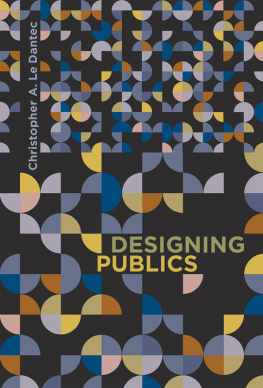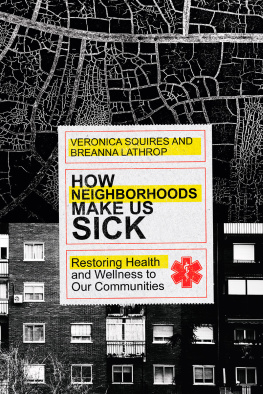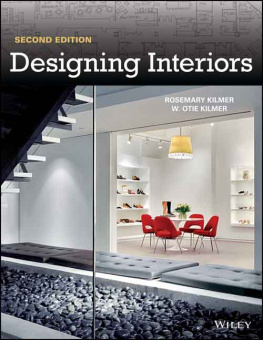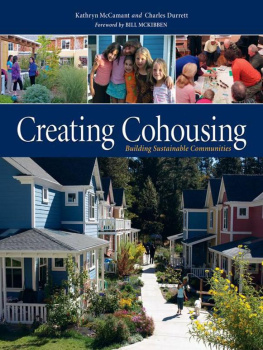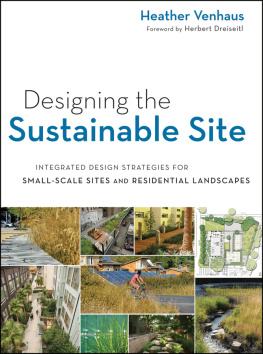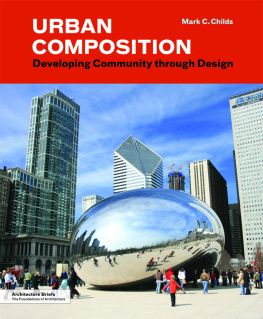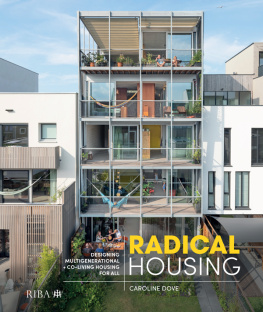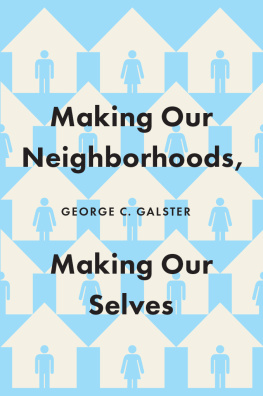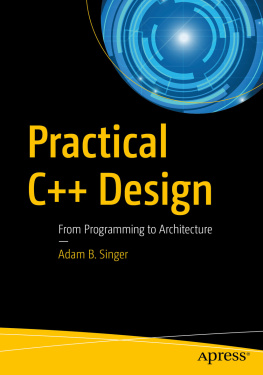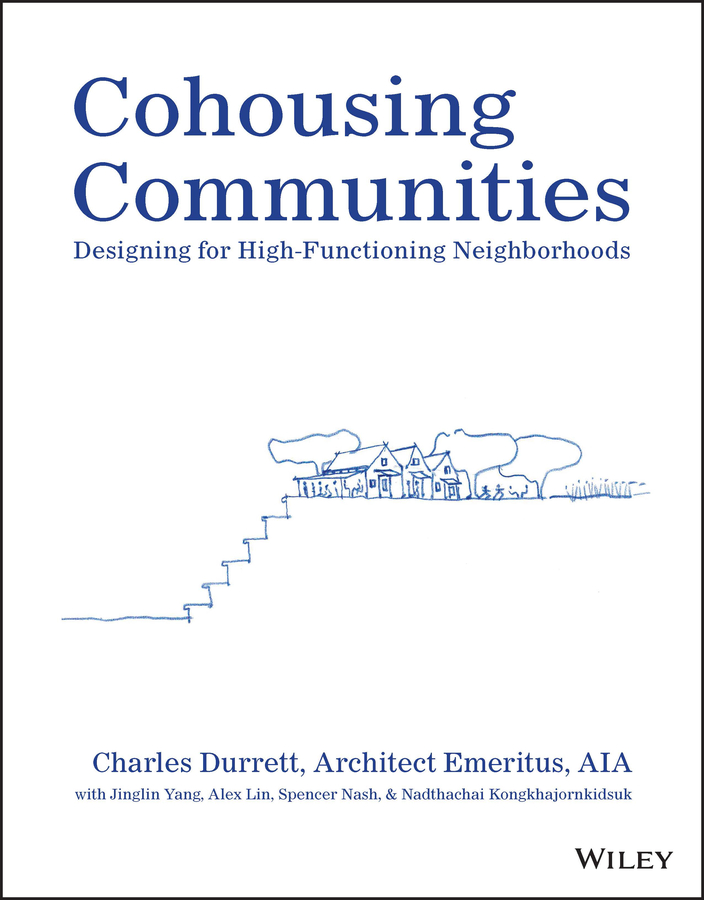
Table of Contents
Guide
Pages
Cohousing Communities
Designing for High-Functioning Neighborhoods
CHARLES DURRETT, ARCHITECT EMERITUS, AIA
WITH JINGLIN YANG, ALEX LIN, SPENCER NASH, AND NADTHACHAI KONGKHAJORNKIDSUK

Copyright 2022 by John Wiley & Sons, Inc. All rights reserved
Published by John Wiley & Sons, Inc., Hoboken, New Jersey
Published simultaneously in Canada
No part of this publication may be reproduced, stored in a retrieval system, or transmitted in any form or by any means, electronic, mechanical, photocopying, recording, scanning, or otherwise, except as permitted under Section 107 or 108 of the 1976 United States Copyright Act, without either the prior written permission of the Publisher, or authorization through payment of the appropriate per-copy fee to the Copyright Clearance Center, 222 Rosewood Drive, Danvers, MA 01923, (978) 750-8400, fax (978) 646-8600, or on the web at www.copyright.com. Requests to the Publisher for permission should be addressed to the Permissions Department, John Wiley & Sons, Inc., 111 River Street, Hoboken, NJ 07030, (201) 748-6011, fax (201) 748-6008, or online at www.wiley.com/go/permissions.
Limit of Liability/Disclaimer of Warranty: While the publisher and author have used their best efforts in preparing this book, they make no representations or warranties with the respect to the accuracy or completeness of the contents of this book and specifically disclaim any implied warranties of merchantability or fitness for a particular purpose. No warranty may be created or extended by sales representatives or written sales materials. The advice and strategies contained herein may not be suitable for your situation. You should consult with a professional where appropriate. Neither the publisher nor the author shall be liable for damages arising herefrom.
For general information about our other products and services, please contact our Customer Care Department within the United States at (800) 762-2974, outside the United States at (317) 572-3993 or fax (317) 572-4002.
Wiley publishes in a variety of print and electronic formats and by print-on-demand. Some material included with standard print versions of this book may not be included in e-books or in print-on-demand. If this book refers to media such as a CD or DVD that is not included in the version you purchased, you may download this material at http://booksupport.wiley.com. For more information about Wiley products, visit www.wiley.com.
Library of Congress Cataloging-in-Publication Data applied for
ISBN: 9781119897705 (Paperback)
ISBN: 9781119897729 (ePDF)
ISBN: 9781119897712 (ePub)
Cover image: Courtesy of Charles Durrett
Cover design: Wiley
This book is dedicated to all the teachers out there who taught us that architecture is about so much more than sexy faades. It is also about making lives and environments better than what we are accustomed to, because they need to be better. Those teachers taught us that architecture can serve society, and therefore we can create viable societies, and that architecture can address our most noble intentions in building healthier and just realities through environmental design. And it can. Thank you.
Introduction
Five years of architecture school in California did not prepare me for designing community-enhanced neighborhoods or cohousing communities. Cohousing was a foreign concept here in the U.S. and even the notion of multi-family with enhanced community facilities, such as a place to break bread together, sharing tools, lawnmowers and cars; private kitchens oriented toward common spaces, and remote parking to keep the center free of cars, is rare. Realizing this, Kathryn McCamant and I went off to Denmark to study cohousing design and community-enhanced developments from the best of the best in the world; from the people who started cohousing in Denmark (Jan Gudmand-Hyer), perfected it (Tegnestuen Vandkunsten), and mastered its programming (Jan Gehl and Hans Skifter Anderson). Once we had convinced our many mentors there that we were serious (and not just another looky-look), it was obvious to them and us that we were not ready to practice after only six months. So, we stayed for another seven months before we felt like we could design cohousing and community-enhanced housing as well as they had done. It was too important to do otherwise. As an architect, it wouldn't be ethical for me to take a penny from anyone to design their community or even to say that I could if I didn't know exactly what I was doing. A routine knee surgery op might be easy with learned hands, but you wouldn't want it to be the surgeon's first time, not to mention his not having gone to medical school.
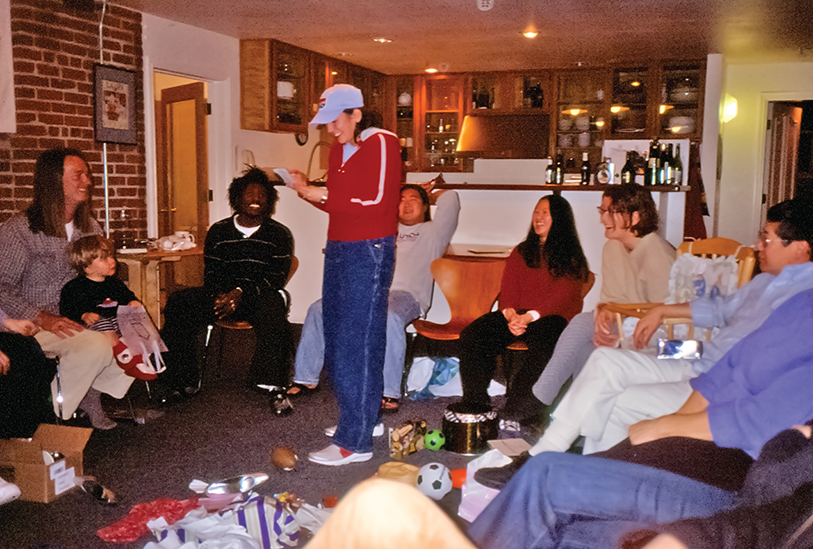
EMERYVILLE, CA
The second cohousing community finished in the U.S., completed in two years. Most of the residents were born outside of the U.S. and had experienced true community previously in their lives, so they were excited to embrace it again.
Undoubtedly the most important lesson we learned was that the difference between what works to enhance community and what doesn't can be subtle, but the results are vast and the impact on a community is permanent. For example, in a poorly designed cohousing community, a common house might receive less than 50 people-hours of use per week, whereas in a well-designed cohousing community, the common house might receive more than 450 people-hours per week. And they both cost about $500,000 to build! Whether it's people-hours in the common house or people-hours on the sidewalks, individual smiles per half-hour, or collective smiles per half-hour, design makes all the difference.
My mantra is, If it doesn't work socially, why bother? How to make that happen is not always obvious. Subtle design factors affect how people feel about their community and their own homes. For instance, buildings that feature natural light have a major positive impact on these feelings. Likewise, the relationships between spaces and other experiential metrics (how close or far things are from each other, acoustics, and hundreds of other little details) affect how happy people are collectively. The arrangement of spaces across the landscape, the common house location, and the floor plans of the private houses impact how happy people are and affect the experiential progressions of what happens first, second, third, and so on as residents walk through the site. These design decisions all have major implications on the social metrics of a given community, such as the amount of conversation on the sidewalks to the number of times people visit each other's houses. All this is to say that this book is a critical resource for anyone interested in living in, learning about, or designing a high-functioning neighborhood. With it, you will have a much better idea of what really matters and why.
Cohousing Communities: Designing for High-Functioning Neighborhoods is designed to help local architects, both new and experienced, to successfully create these enhanced communities. Very few architects have experience in designing cohousing or high-functioning neighborhoods. Even after designing more than 50 cohousing communities and a hundred multi-family buildings and/or neighborhoods, I am still learning. I always feel like my next one will be the best one. I want you, the designer and consumer, to have the best point of departure that you caninformed by what we have learned over the past 35 years. This knowledge must be shared for future generations of architects who hope to create housing that provides people with more than just a place to sleep, eat, and watch TV. When the Danish architects Jan Gudmand-Hyer and ngels Colom both retired at the same time, the result was noticeable. Upon losing two of the most experienced architects in Denmark, cohousing and neighborhood design there took a dive. Multi-family developments in Denmark started to feel like apartments again, instead of communities. During those years, ironically, seven Danish architects did six-month internships in our office. After returning home to Denmark, they went on to design extremely successful new cohousing communities, and a second wave of success is well underway there.
Next page

